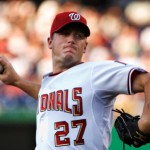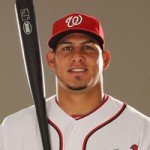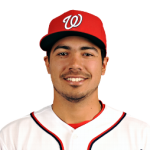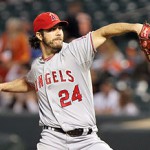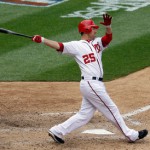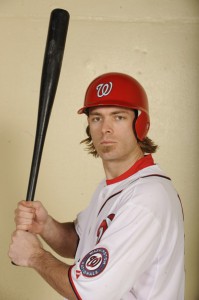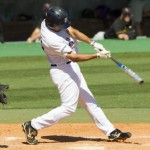
He’s continued to hit in the pros like he used to in college. Photo: Brett Coomer/Houston Chronicle via chron.com
The Nats continue to struggle offensively. They’re generally only above the Mets and the Marlins in key offensive categories, two teams that have basically given up for 2013. They’re hitting worse than the Astros, a team that also had given up on 2013 before it started and whose payroll is 1/6th of ours. Our best hitter Bryce Harper languishes on the D/L, but the team has (finally) made some adjustments and shed some of the underperforming players on its roster and rookie Anthony Rendon has been living up to his expectations.
So, what is Tom Boswell‘s weekly chat is going to be about? Here’s his 6/17/13 version. As it turned out many of the questions were about the US Open, and a few about Hockey and Football. But lots about baseball. As always I answer here before reading Boswell’s response and edit questions for clarity.
Q: Is Davey Johnson the problem with the Nats in 2013?
A: Despite some complaints about his Starting Pitcher and bullpen usage earlier this year, Davey Johnson isn’t the reason this team is losing. Not with a team whose offense ranks 28th in the league in all the basic run-creating categories (Runs, Batting Average, OBP, and OPS+). Changing the manager won’t help; all you can do is change the personnel. And the Nats have done what they can; sending Tyler Moore and Danny Espinosa to the minors, calling up Rendon (slash line as of 6/16/13: .361/.426/.525; yeah that’s pretty darn good), giving Chris Marrero some at-bats. The obvious: they need Harper back, they need the bench to start producing like it did in 2012, and they need Wilson Ramos to come back and spell the quietly falling-apart Kurt Suzuki (he’s now hitting just .215 with little power). Boswell agrees; its the offense.
Q: Did Johnson screw up by not loading the bases in the Friday loss?
A: Situation: 2nd and 3rd with none out; do you load the bases? I’d normally say that it depends on the matchups; a fly ball beats you anyway, so you’re looking for a pitching matchup that you can either get a punch out or a ground ball. Well, they got their groundball; it just wasn’t enough to get the guy at the plate, who broke on contact and was fast. A bases-loaded situation there means Suzuki doesn’t have to make the tag, just get the force out. I guess Johnson could have loaded the bases. Boswell points out the similarities to this and the NLCS Game 5 situation with Pete Kozma but doesn’t give an answer.
Q: Is Rick Eckstein culpable for the Nats Offensive woes?
A: Boswell answered an identical question on 5/28/13. I’ll say the same thing again: I just don’t see how a hitting coach is responsible for players who suddenly hit 200 OPS points below their career averages as we’re seeing with a huge percentage of this team. Rick Eckstein isn’t in the batter’s box; these guys are. Boswell agrees, saying it isn’t Eckstein who is waving at balls a foot outside.
Q: Are the Nats just mentally fragile?
A: Possibly. I think the weight of expectations is causing them to press. But you have some veteran guys in that clubhouse (Jayson Werth, Adam LaRoche especially) who should be leading the team and helping to manage this. Maybe these guys just aren’t “Captain” material? Notice too that the two most senior guys on the pitching staff (Dan Haren and Rafael Soriano) aren’t exactly the best role models either; Haren is struggling too much to command any respect, and Soriano doesn’t appear to be a big clubhouse influence (and I privately wonder if there isn’t lingering animosity towards Soriano’s signing from the rest of the bullpen, which seems relatively close in age and experience). Boswell notes that the team leaders need to step up.
Q: Why is Dan Haren pitching again?
A: Asked and Answered here four days ago. Boswell didn’t really answer.
Q: Should we eliminate pitcher Wins and Losses?
A: Well, if you’re a sabrematrician we should. A pitcher can give up one hit in 5 innings (as Stephen Strasburg did on sunday) and take the loss, while a pitcher can give up 5 runs in 5 and get a win if his offense bails him out. That in a nutshell is the issue most people have with the Win and Loss statistics. I saw a stat on billy-ball.com today that Chad Billingsley took the loss in an 8-inning one-hit outing in 2011 (the run was un-earned to boot). That’s pretty unlucky. Bill James said recently that he continues to use W/L records simply because they’ve been the default way to express stats for pitchers for 100 years. I now view them sort of as throw-away stats written ahead of the meaningful measurements for pitchers, things like Fip and xFip, perhaps Siera. I like ERA+ and K/9 as good short-hand measurements too, but realize that every one of these stats has flaws. The pitcher “Win” used to mean a lot more than it does now; when a guy went 9 innings every day instead of going 5 2/3 and having a bullpen close out more than a third of the game it becomes harder and harder to equate one with with another. Boswell agrees.
Q: How much of Rendon’s hitting is a reflection of his talent, and how much of it is a product of teams not having a book on him yet? Certainly he’s not a .350 hitter, but is he a .300-.310 hitter?
A: Great question. I think its part column A and part column B. For one, he’s an exceptional hitter. He wasn’t College Player of the Year as a sophomore at Rice by accident. He should have been a 1-1 pick had it not been for lingering issues that dropped him into the Nats lap in 2011. And in his short sample size so far in 2013 we’re seeing his great approach; fast hands, ability to use the whole field, opposite field power. Now, a new hitter hasn’t had “the book” written on him (that’s what advance scouts do) so yes, we’ll expect to see teams identify weaknesses in Rendon’s swing and start pitching him accordingly. The great players then adjust to the adjustments. In the ESPN documentary Bryce Begins there was a very telling quote from Braves pitcher Kris Medlen, who commented that Harper had “already made the adjustment” to the way the Braves were pitching him from one series to the next. The film then showed Harper fanning at a pitch to strike out .. and then clobbering the same pitch in a subsequent game. That’s what pro hitters do to stay good, and that’s what Rendon is going to have to eventually do to keep his lofty average. Boswell raves about his stat lines all the way up the minors.
